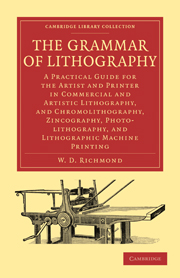 The Grammar of Lithography
The Grammar of Lithography Book contents
- Frontmatter
- Contents
- EDITOR'S INTRODUCTION
- PART I DRAWING, TRANSFERRING AND PRINTING
- CHAPTER I Introductory
- CHAPTER II Mechanical and Chemical Principles of some of the Lithographic Materials used in Printing
- CHAPTER III Instruments, Tools, and Appliances used in Drawing and Writing
- CHAPTER IV Instruments, Tools, and Apparatus used in Printing
- CHAPTER V Accessories to the Lithographic Printing-press
- CHAPTER VI Grinding and Polishing Stones
- CHAPTER VII Lithography on Paper or Transfer Lithography
- CHAPTER VIII Ink Writing and Drawing on Stone
- CHAPTER IX Chalk Drawing on Stone
- CHAPTER X Etching Chalk Drawings on Stone
- CHAPTER XI Taking Impressions for Transferring
- CHAPTER XII Transferring
- CHAPTER XIII Proving and Printing
- CHAPTER XIV Printing (continued)
- CHAPTER XV Printing (continued)
- CHAPTER XVI Miscellaneous Processe
- CHAPTER XVII Miscellaneous Processes (continued)
- CHAPTER XVIII Engraving on Stone
- CHAPTER XIX Zincography
- CHAPTER XX Chromo-lithography
- CHAPTER XXI Chromo-lithography (continued)
- CHAPTER XXII Chromo-lithography (continued)
- CHAPTER XXIII Chromo-lithography (continued)
- CHAPTER XXIV Photo-lithography
- APPENDIX.—Recipes
- PART II LITHOGRAPHIC MACHINE-PRINTING
- BIBLIOGRAPHY OF LITHOGRAPHY
- INDEX
CHAPTER XII - Transferring
Published online by Cambridge University Press: 05 July 2011
- Frontmatter
- Contents
- EDITOR'S INTRODUCTION
- PART I DRAWING, TRANSFERRING AND PRINTING
- CHAPTER I Introductory
- CHAPTER II Mechanical and Chemical Principles of some of the Lithographic Materials used in Printing
- CHAPTER III Instruments, Tools, and Appliances used in Drawing and Writing
- CHAPTER IV Instruments, Tools, and Apparatus used in Printing
- CHAPTER V Accessories to the Lithographic Printing-press
- CHAPTER VI Grinding and Polishing Stones
- CHAPTER VII Lithography on Paper or Transfer Lithography
- CHAPTER VIII Ink Writing and Drawing on Stone
- CHAPTER IX Chalk Drawing on Stone
- CHAPTER X Etching Chalk Drawings on Stone
- CHAPTER XI Taking Impressions for Transferring
- CHAPTER XII Transferring
- CHAPTER XIII Proving and Printing
- CHAPTER XIV Printing (continued)
- CHAPTER XV Printing (continued)
- CHAPTER XVI Miscellaneous Processe
- CHAPTER XVII Miscellaneous Processes (continued)
- CHAPTER XVIII Engraving on Stone
- CHAPTER XIX Zincography
- CHAPTER XX Chromo-lithography
- CHAPTER XXI Chromo-lithography (continued)
- CHAPTER XXII Chromo-lithography (continued)
- CHAPTER XXIII Chromo-lithography (continued)
- CHAPTER XXIV Photo-lithography
- APPENDIX.—Recipes
- PART II LITHOGRAPHIC MACHINE-PRINTING
- BIBLIOGRAPHY OF LITHOGRAPHY
- INDEX
Summary
The methods of taking impressions suitable for transferring having been described in the last chapter, we proceed now to show the manner of putting them down upon the stone, so that they may be printed from. There are three distinct variations of transferring, each having its own special advantages.
1st. Transferring damped transfers to dry stone, either warm or cold.
2nd. Dry transfers to wet stone, and
3rd. Damped transfers to wet stone.
110. Transferring to Dry Stone is the mode usually, and in some offices invariably, adopted. The stone may be warm or cold, but in all cases must be thoroughly dry. If the drawing, writing, copper transfer, or other work, is of an unusually fine character; or if the ink used is of a very hard nature, the stone may be warmed with advantage; but it should not be made hot, or the transfer-ink may spread, as it can hardly be expected but that some part of the work will contain heavy lines, which would, of course, be more liable to spread than finer ones.
The damping of the transfer-paper requires care and experience, and may be done as described in par. 104. It has before been stated that the object is to render the composition sufficiently adhesive to stick to the stone under pressure, and this may be ascertained by taking a corner of the paper containing no work, and squeezing it between the finger and thumb, to which, if it attaches itself by the composition, the transfer is ready for the stone. Care must be taken that the thumb and finger are not damp or the transferrer may be thereby deceived.
- Type
- Chapter
- Information
- The Grammar of LithographyA Practical Guide for the Artist and Printer in Commercial and Artistic Lithography, and Chromolithography, Zincography, Photo-lithography, and Lithographic Machine Printing, pp. 82 - 89Publisher: Cambridge University PressPrint publication year: 2010First published in: 1878


